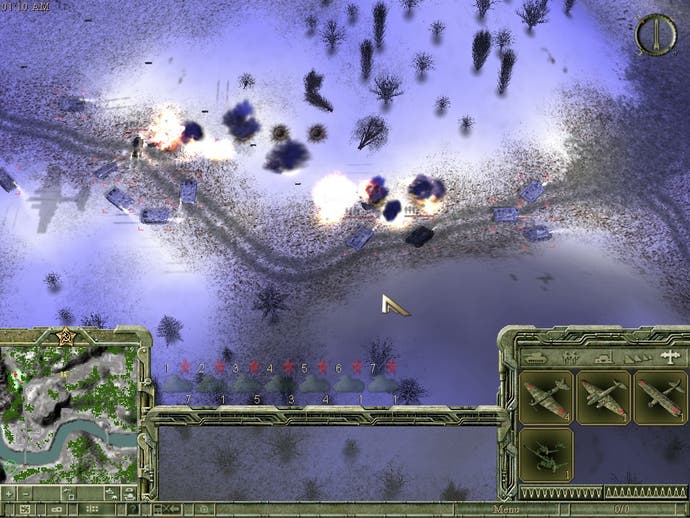Frontline Attack: War Over Europe
Hands-On - we take the new World War II real-time strategy game for a pre-release spin

Midway
Although Frontline Attack is allegedly based on the new Earth 3 engine, the interface, terrain and special effects all look eerily familiar at times. It's hard to tell what, if anything, has been changed since the last version of the engine, but fortunately the visuals are still quite attractive, if not as spectacular as they seemed back in 2000.
There have been some changes on the gameplay front though, with the focus in the main single player campaigns switching to tactical combat rather than base building and resource gathering. You're provided with a group of units at the beginning of each mission, with further forces often arriving as reinforcements on completion of each objective. You will also be able to call on support from heavy artillery, bombers and air recon units in some missions, and unleashing these at the right time and the right place can often change the course of a battle. As a result the emphasis is on using your limited forces as best you can, rather than churning out dozens of tanks and obliterating your enemy through force of numbers, which makes for a more realistic experience.
Frontline Attack is still very much a real-time strategy game at heart though, and a far cry from the likes of Combat Mission and the Close Combat series. There's no unit moral or fatigue to worry about and vehicles have unlimited fuel, only requiring occasional ammunition resupplies. You can even use a repair truck to rapidly patch up damaged tanks mid-mission. The game also gets back to its roots in the multiplayer and skirmish modes, where you occupy factories and mines to earn money which can then be spent on new buildings and units in true RTS fashion. It's almost like having two games in one, and the skirmish mode came as quite a culture shock after few days exploring the campaigns.

Panzer Declawed
The game includes several campaigns split amongst Russian, German and (primarily American) Allied forces, with each side having their own selection of historical units, ranging from tanks and armoured cars to various types of infantry and support vehicles. Some maps also feature bunkers, anti-aircraft positions and anti-tank and machinegun nests which can be occupied by your infantry, while in skirmish mode and multiplayer matches you can build your own defensive positions.
Commanding these troops is fairly straightforward, although they're not always tremendously responsive and tend to get easily distracted. It doesn't help that the game uses a primitive grid system for collision detection. Because of this units can end up dancing around each other in narrow streets and valleys as they try to get into position, and a lone tree will prove an insurmountable object even for an infantry unit.
Game balance also feels a little contrived at times, most noticeably in the way that vehicles and infantry interact. Tanks cause virtually no damage to infantry, which is odd, because we were under the impression that most World War II tanks came fitted with machineguns as well as their main cannon. You can drive over infantry units, but this only happens if you give a direct order to run down a specific unit, and the enemy AI will do its best to avoid becoming roadkill. In return, only special anti-tank and grenadier infantry can cause any real damage to tanks, as normal foot soldiers apparently don't carry grenades. This means that you can end up with a tedious stalemate if you run out of infantry to support your tanks and come up against some enemy soldiers, while missions can become virtually impossible to complete if you only have infantry left. While it's nice that you have to learn to use different types of unit together, the way the developers have gone about achieving this is heavy-handed. This is only made worse by the fact that your units will quite happily fire away at an enemy they stand virtually no chance of destroying, even when a more appropriate target becomes available, resulting in a lot of frantic clicking as you try to convince your units to shoot at the right targets.
Conclusion
Frontline Attack does have potential, but the build we played had a lot of rough edges. If these can be smoothed out in the few weeks remaining before the game appears on the shelves then this could be a nice change from painfully realistic World War II strategy games like Sudden Strike and Close Combat. In the meantime we'd suggest waiting for our review of the final release version before deciding whether to take the plunge.







